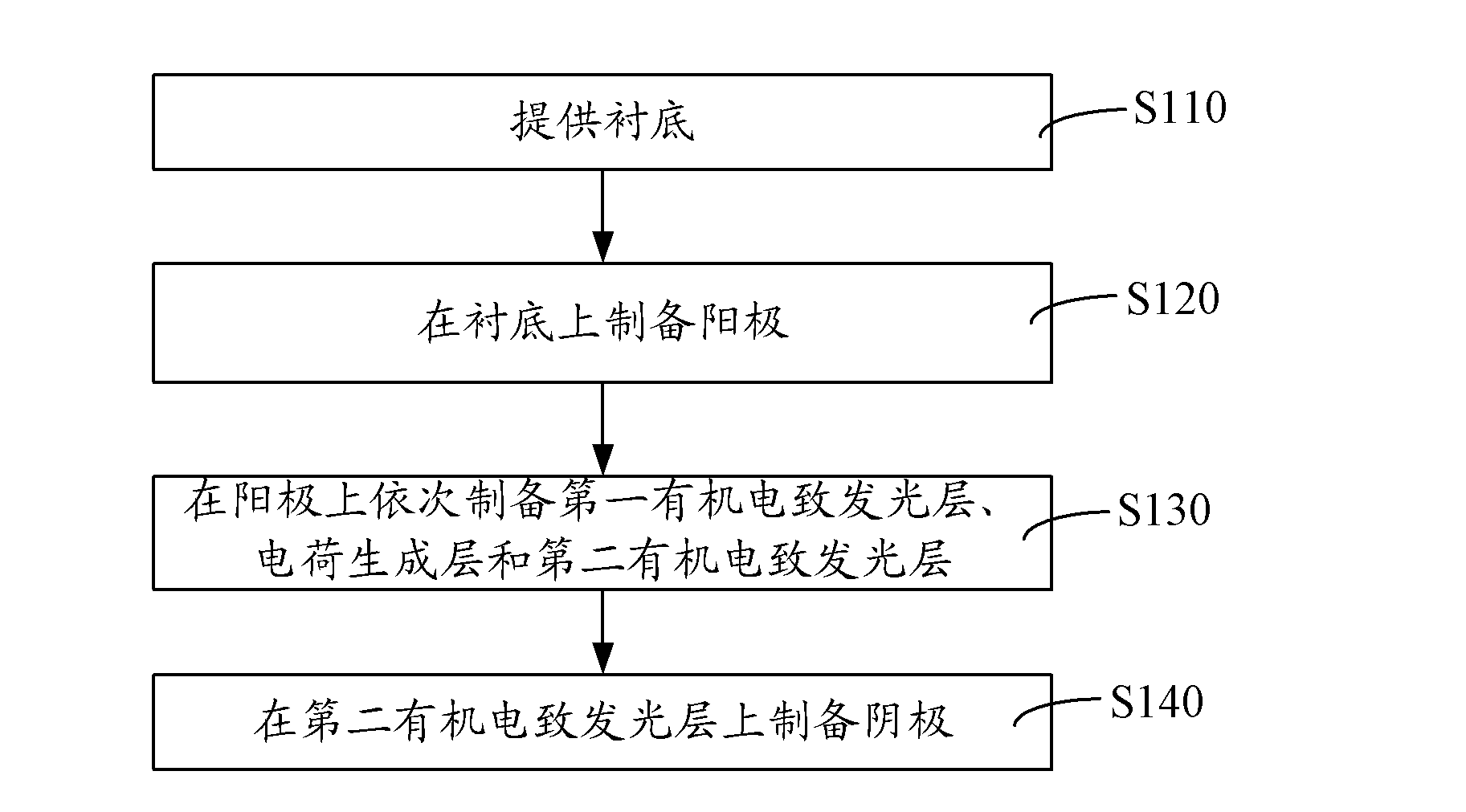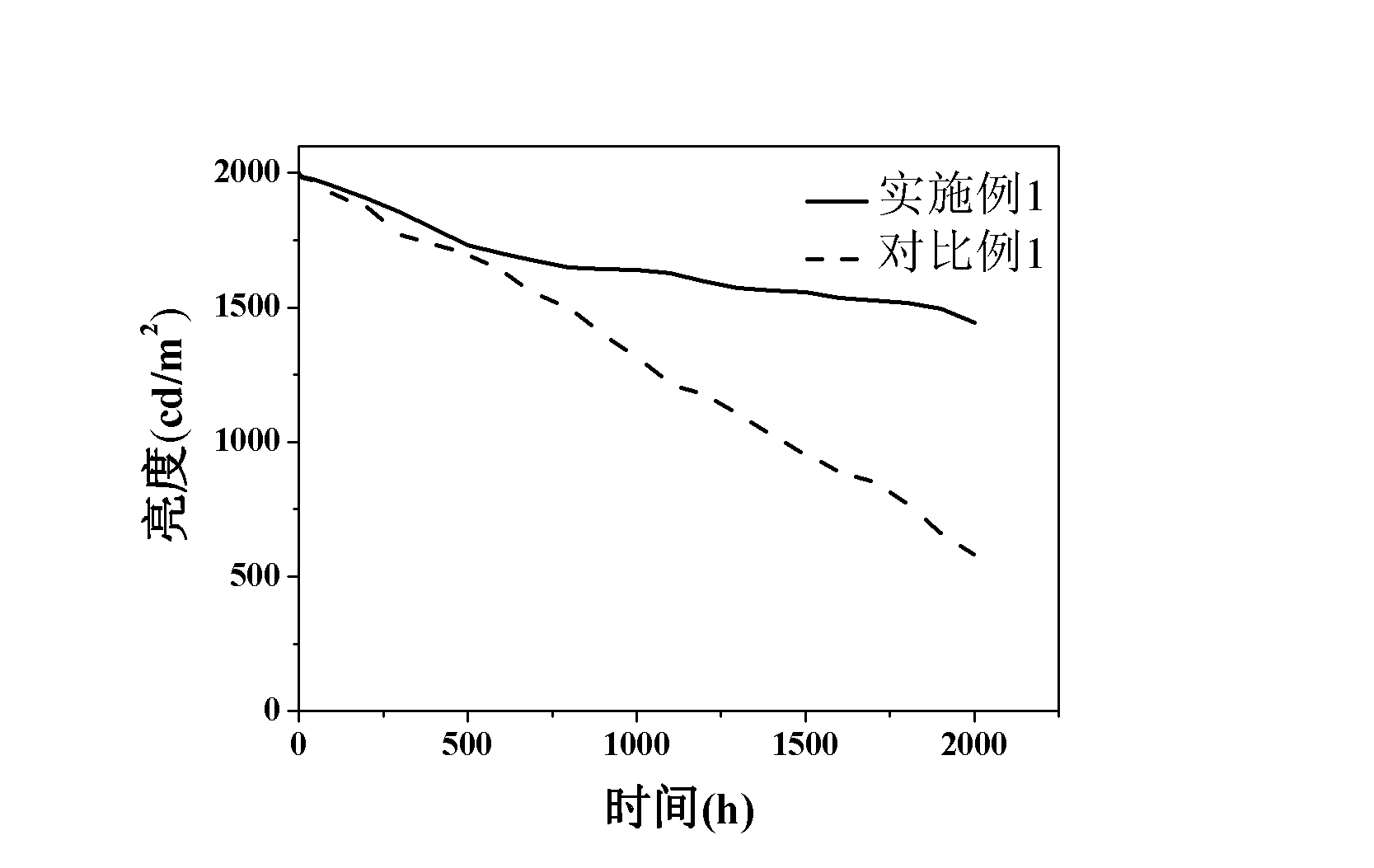Organic electroluminescent device and production method thereof
An electroluminescent device and electroluminescent layer technology, applied in the direction of circuits, electrical components, electric solid devices, etc., can solve the problems of large driving current, restricting the application of organic electroluminescent diodes, and low device life
- Summary
- Abstract
- Description
- Claims
- Application Information
AI Technical Summary
Problems solved by technology
Method used
Image
Examples
preparation example Construction
[0050] see figure 2 , the preparation method of the organic electroluminescence device of an embodiment, comprises the following steps:
[0051] Step S110: providing a substrate.
[0052] The substrate may be a glass substrate or a polyethersulfone resin substrate. After the substrate is washed, first place the substrate in deionized water containing detergent for ultrasonic cleaning, after cleaning, use ultrasonic treatment in isopropanol and acetone for 20 minutes, and then dry it with nitrogen to obtain a clean substrate. end.
[0053] Step S120: preparing an anode on the substrate in step S110.
[0054] In the vacuum coating system, a transparent conductive oxide or metal is evaporated, and a transparent conductive oxide film or a thin layer of metal is prepared on the substrate as an anode.
[0055] The transparent conductive oxide may be indium doped tin oxide (ITO), indium doped zinc oxide (IZO), aluminum doped zinc oxide (AZO) or gallium doped zinc oxide (GZO). T...
Embodiment 1
[0067] After the glass substrate is cleaned, in a vacuum sputtering system, an indium-doped tin oxide (ITO) film with a thickness of 100 nanometers is sputtered on its surface. After plasma treatment, it is then transferred to a vacuum thermal evaporation system. The first organic electroluminescence layer, the charge generation layer, the second organic electroluminescence layer and the cathode are sequentially evaporated on the surface of the ITO thin film.
[0068] The structure of the prepared first organic electroluminescent layer is:
[0069] m-MTDATA / NPB / Ir(ppy) 3 :CBP / Alq 3 / LiF.
[0070] The structure of the prepared second organic electroluminescent layer is:
[0071] m-MTDATA / NPB / Ir(ppy) 3 :CBP / Alq 3 / LiF.
[0072] The structure of the prepared charge generation layer is Mg / MoO 3 / Au, the thicknesses are 3 nm, 5 nm, and 15 nm, respectively.
[0073] The device structure is glass substrate / ITO / m-MTDATA / NPB / Ir(ppy) 3 :CBP / Alq 3 / LiF / Mg / MoO 3 / Au / m-MTDATA / NP...
Embodiment 2
[0075] After the glass substrate is cleaned, in a vacuum sputtering system, an indium-doped zinc oxide (IZO) film with a thickness of 120 nm is sputtered on its surface, and after plasma treatment, it is then transferred to a vacuum thermal evaporation system , vapor-depositing a first organic electroluminescent layer, a charge generation layer, a second organic electroluminescent layer and a cathode on the surface of the IZO thin film.
[0076] The structure of the prepared first organic electroluminescent layer is:
[0077] CuPc / TPD / FIrPic:CBP / TPBi / CsF.
[0078] The structure of the prepared second organic electroluminescent layer is:
[0079] m-MTDATA / TPD / (F-BT) 2 Ir(acac):CBP / TPBi / CsF.
[0080] The structure of the charge generation layer used is Yb / MoO 3 / Au, the thicknesses are 2 nm, 3 nm, and 10 nm, respectively.
[0081] The device structure is glass substrate / IZO / CuPc / TPD / FIrPic:CBP / TPBi / CsF / Yb / MoO 3 / Au / m-MTDATA / TPD / (F-BT) 2 Ir(acac):CBP / TPBi / CsF / Al.
PUM
 Login to View More
Login to View More Abstract
Description
Claims
Application Information
 Login to View More
Login to View More - R&D
- Intellectual Property
- Life Sciences
- Materials
- Tech Scout
- Unparalleled Data Quality
- Higher Quality Content
- 60% Fewer Hallucinations
Browse by: Latest US Patents, China's latest patents, Technical Efficacy Thesaurus, Application Domain, Technology Topic, Popular Technical Reports.
© 2025 PatSnap. All rights reserved.Legal|Privacy policy|Modern Slavery Act Transparency Statement|Sitemap|About US| Contact US: help@patsnap.com



